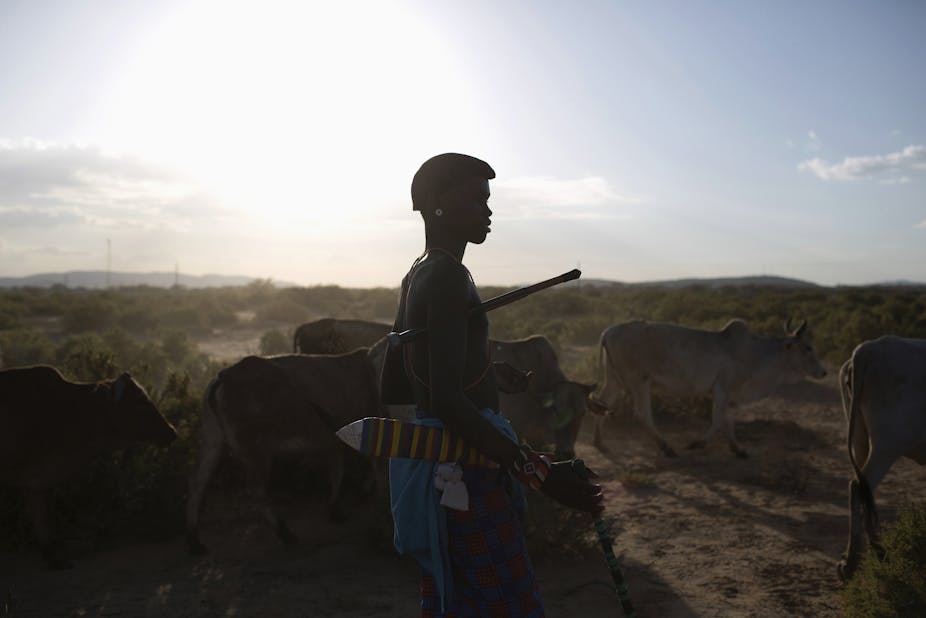Armed pastoralist groups have, over the past few months, forcefully moved their livestock herds onto ranches or conservancies in Laikipia, central Kenya. Property has been destroyed, wildlife killed and tourists have been caught up in the clashes.
There is a simplistic assumption that this is due to an ongoing drought or that the cattle raids are part of traditional pastoral conflict. It’s true that the pastoralist march on private land is in part for grazing and water. But in fact their actions are also a form of resistance to an unequal distribution of resources.
Laikipia is an area characterised by valuable resources and diverse communities. This has created a complex political story with its roots in resource and land grabbing, political wrangling and human-wildlife conflict.
Land distribution
Land-based grievances are what could have triggered these recent invasions. 2017 is an election year in Kenya and these are often used in political campaigns. They have already been witnessed in Isiolo - an area that neighbours Laikipia - where, conservancies are also being invaded by pastoralists, spurred on by local politicians. This political dynamic can also be seen in Laikipia.
These grievances are an easy rallying cry as many pastoralists in the area lost access to their ancestral pasture lands in the early 20th century when British imperialists forcibly removed the Maasai pastoralist community from the Rift Valley and Laikipia. They were moved to the area now known as the Maasai Mara, near the border of Tanzania.
What ensued created a mosaic of land tenure arrangements. The Maasai’s relocation enabled European settlement and agricultural production in the favourable ecological conditions of the Rift Valley – an area which came to be known as part of the “White Highlands”. Africans were restricted to certain areas, largely based on ethnicity.
When independence came, it signalled the move towards individual land rights and redistribution schemes. But these schemes were criticised for putting land into the hands of a few political elites. In Laikipia, the majority of Kenyans were settled on smallholdings in the west, or remained landless. Group ranches, where a group of people collectively own freehold title to land, were set up predominantly in the north while some private ranches from the colonial period kept their land.
Human-wildlife conflict
Over time conservation areas – or conservancies were set up. These were either former ranches that moved into wildlife management or were set up by a community. Laikipia has an abundance of wildlife and these areas act as a form of public private partnership with the Kenya Wildlife Service. They are mandated to manage Kenya’s wildlife and offer tourism opportunities which can attract premium prices.
But the conservancies have created conflict with some surrounding communities. There is deep inequality within Laikipia between those who reap the benefits of wildlife and those who bear the costs.
Due to the land arrangements, many smallholders in Laikipia are situated outside the conservancies or within wildlife migratory corridors. As a result, they suffer both livestock or crop destruction. For privately-run conservancies there are concerns that this is a legitimate way to concentrate large tracts of land and valuable wildlife-related economic activities in the hands of a few individuals.
Also troubling is the use of National Police Reservists by private conservancies. These scouts are private employees. But they are armed by the government through the national police reservists initiative for the purpose of maintaining “wildlife security”.
The scouts are empowered to use violence to stop poaching, but also act in security matters beyond the conservancy of their employment, such as tracking raided cattle. This has the potential to escalate conflict between private and public interests.
Political dimensions
Today the conflicts are also overlaid with corruption – particularly the misappropriation of funds that could have been used for rural development. Instead they serve political interests with some benefiting financially from the raids.
The raids have become a political tool for those looking for votes in exchange for water and pasture. And so, fuelled by the proliferation of arms within pastoral communities, some politicians reportedly use their positions to incite their constituents to take up arms and lay blame for the lack of resources elsewhere. Cattle raids are therefore often perpetrated by criminal gangs with links to corrupt government or political actors.
Previous disarmament programs have sought to address the arms problem but have been criticised for the excessive use of force by police or military. They have also been criticised for leaving disarmed communities vulnerable to attack by those communities that haven’t been disarmed.
A solution?
This is not a new issue. There have been many incidents of invasions throughout the past few decades. However, the continual framing of these invasions as responses to drought fail to address the underlying dimensions of resource distribution. Short-term programs to address famine and drought do not guard against future invasions.
They will continue to occur in the absence of genuine conversations about issues of governance, the sharing of benefits and resource management in Kenya. Rainfall and ecological conditions simply act to exacerbate the tensions.
Until governance issues such as corruption, policy, security, management of resources and development within rural areas are addressed, the conflict will continue.

